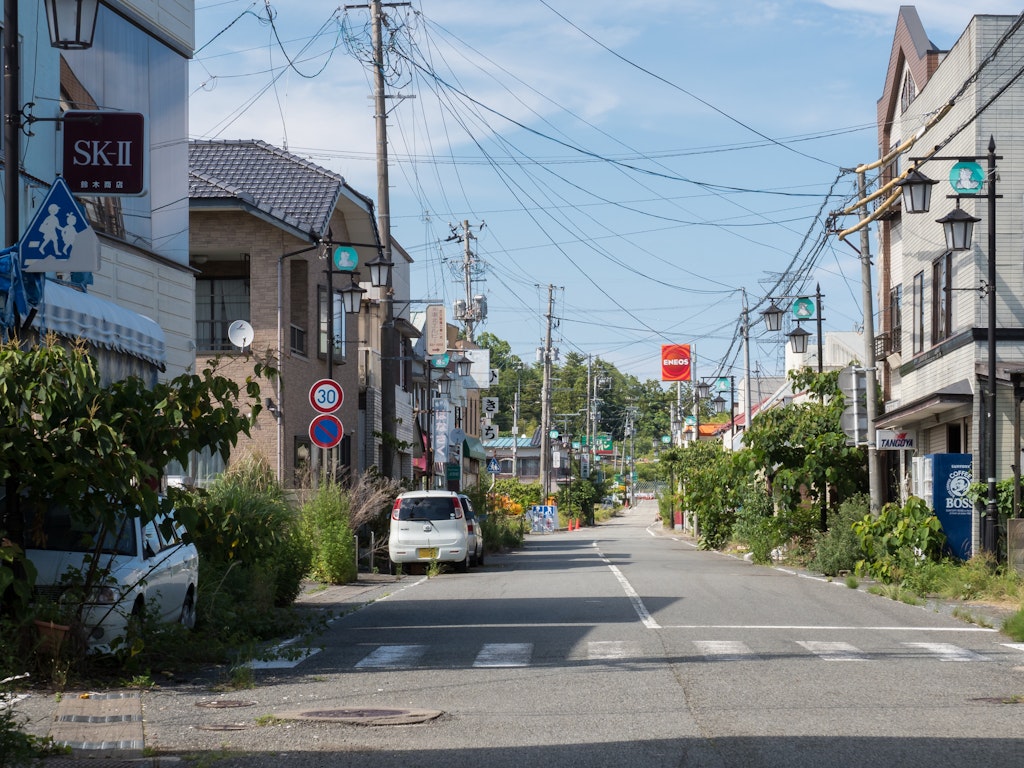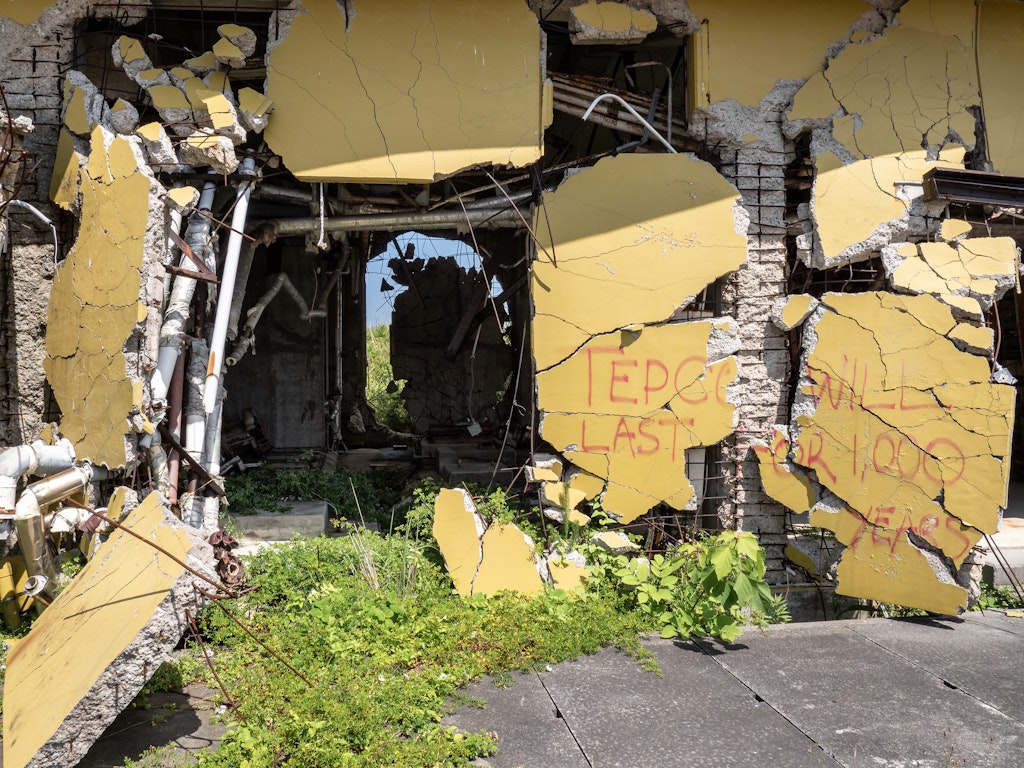In June 2019 I visited the exclusion zone and surrounding areas of Fukushima, Japan with the tour group www.real-fukushima.com.
This tour is run in association with the Fukushima Prefectural Government and it's aim is to educate visitors about the cause, affect and recovery of the 2011 Fukushima Daiichi Nuclear Power Plant triple disaster. The tour was led by Ms. Karin Taira, a local who also runs a bnb in the area. The tour is very much focussed on education, and as such respects the privacy of the property in the exclusion zone. We were strongly encouraged to respect the privacy of the people and were only able to take images in certain designated places.
In 2011 an Earthquake shook Japan, and cut power to the pumps keeping the nuclear reactor cool. Backup diesel generators kicked in, and maintained the flow of cooling water. A 15 meter tsunami then struck the coast, easily overwhelming the 7-10 meter sea wall and flooding the diesel generators and causing 12 of 13 to fail. Once flood waters had receeded a huge effort was made with batteries, backup power units and attempts to reconnect power. Unfortunately the efforts were not successful and the nuclear fuel melted, causing a hydrogen explosion that blew the roof off reactor unit 1. Unit 2 was vented over the next few days to prevent a similar explosion, which is the source of much of the leaked radiation. Later reactor 3 also exploded as venting was not successful, this flowed into unit 4 also causing an explosion. Radioactive particles were ejected into the air and sea, causing a 20km evacuation zone. This led to the evacuation of over 150,000 people, only a fraction of whom have returned to areas now open for re-settlement.
In terms of radiation, the areas that we visited across the space of 4 hours exposed us to around about the same radiation as a dentist's x-ray. We received more radiation in the flight from Australia to Japan. The area is not safe to live, but for a short visit the tour is very safe. Workers in the area also no longer need to wear hazmat suits. Airborne radiation is minimal, however radiation is still quite high in bushes and forests and potentially inside area that have not been washed by rain. The tour does not spend time in these areas.


The new containment roof over reactor 3. Reactor 2 is to the left, with the damaged roof of reactor 1 to the left of that. Reactor 4 is on the right hand side.
Our tour started with a visit to one of the local residents, 93 year Mr. Seimei Sasaki. Seimei san evacuated in 2011, and has only been able to return to his property in the last 3 months. We spent an hour discussing his life, his experiences and the future problems facing the Fukushima region. One of his most powerful stories is of when he evacuated to live with his nephew in Tokyo. He had to move again after only a short while as his nephew's daughter was being teased that she was contaminated.
In his opinion, the biggest problem now facing the region is that all of the families and businesses were assisted by the government to move and set up outside the evacuation area in Fukushima, and in other prefectures.
Agriculture has now resumed in the reopened areas since the top soil is largely decontaminated so local produce from this region. The problem is not so many famers have returned that’s why the huge scale of the lands are still left and devastated. Fishing is also allowed, and is controlled and monitored by Fukushima Prefecture and the Fisheries Agency. This industry is still a long way from recovering, but radiation is no longer detectable in the produce.
As work opportunities are so greatly reduced, young families are not returning. Out of 80 families that lived in his village, only 20 have returned, and most of those are elderly.
It was so moving and powerful to have the opportunity to speak with an elder of the local community and gain his insight.




We learnt on the tour that part of the decontamination process was to remove millions of cubic meters of top soil from the contaminated areas in giant bags. The soil is separate from the bags in industrial scale sorting facilities within the zone, and then stored inside massive concrete lines holes for 30 years, when a permanent home must be found. The operation is manned by thousands of workers making over 1,500 trips per day in trucks laden with contaminated soil.


Thousands of bales of contaminated soil awaiting storage.


We travelled down Highway 6, running through the exclusion zone, that had been closed since 2011. It was reopened in 2014 for travel, however motorbikes, bicycles and pedestrians are forbidden. Many businesses lie abandoned since 2011 along the route. You can see cars in dealer show-rooms, convenience stores, restaurants and entertainment complexes slowly succumbing to nature. This is where the Netflix show Dark Tourist was filmed. This tour helped to show how sensationalised and potentially inauthentic the portrayal was.




Abandoned businesses on Highway 6
Another stop was the town of Okuma, also abandoned since 2011. Time has stood still, with cars left in the street, businesses shut and nature slowly enroaching. Due to the continued work on de-contamination these roads are used, so are in better condition than they would otherwise have been.






The main shopping strip
Perhaps the most overwhelming stock was the Fukushima fish nursery, which stands right on the coast. The nursery used to use the warm waste water from the power plant. This huge building bore the brunt of the tsunami, as it obliterated concrete, and bent re-inforced steel. At least 7 workers were washed away as the water tore through the building. The tsunami was 15 meters high, but the initial wave was 15 meters above that. The sheer terror of that moment must have heart stopping.
This was a building that we were allowed to walk around and freely take images. The huge arches that remain makes the structure feel almost religious in nature, and a fitting place to consider the impact that the disaster had on so many lives.










Details from the fish nursery. Main image at the top of the page is the structure in full.
It may seem like a strange choice to spend a day of vacation in a place that has seen such disaster, and has affected so many lives. As a photographer I am fascinated by the places that we leave behind. There are very few places on the planet with the scale of this disaster.
A good part of my personal work has been spent exploring regional Victorian spaces that have been abandoned to time. I'm also interested in learning about the people in the area, what happened, how did they cope, and how are they recovering. Their stories interests me as much as the unique visual opportunity.
I feel that this tour is a respectful way to explore the region and learn about the disaster and aftermath, in a way that is beneficial to the local population.
I was in two minds, worrying that we were contributing to 'disaster tourism', but I'm glad we made the decision. I felt that this tour was nothing of the sort, and was incredibly educational, with no 'sensationalism'.
Our host, Karin, was wonderful and knowledgable and being a local, spoke with such authenticity.
The tour lasts for approximately 4-5 hours and Fukushima is approximately 3.5 hours from Tokyo by train.


